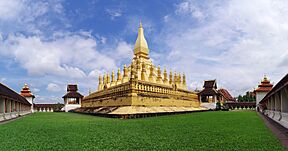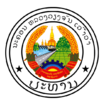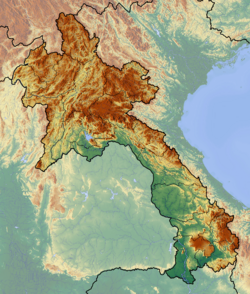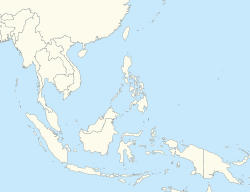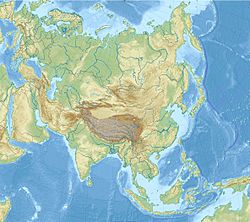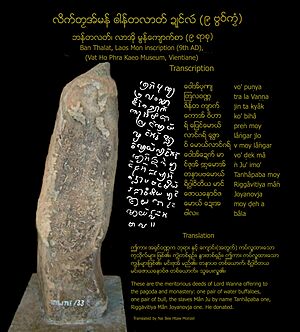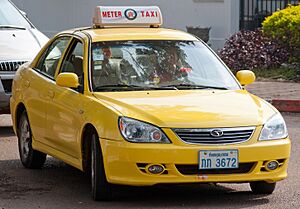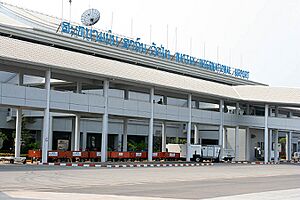Vientiane facts for kids
Quick facts for kids
Vientiane
ວຽງຈັນ
|
||
|---|---|---|
| ນະຄອນຫຼວງວຽງຈັນ | ||
|
From top, left to right: Patuxai; view of Vientiane from the Patuxai; Wat Si Saket; Pha That Luang
|
||
|
||
| Country | ||
| Prefecture | Vientiane Prefecture | |
| Settled | 9th century | |
| Area | ||
| • Total | 3,920 km2 (1,510 sq mi) | |
| Elevation | 174 m (570 ft) | |
| Population
(2023)
|
||
| • Total | 840,940 | |
| • Density | 214.53/km2 (555.6/sq mi) | |
| GDP | ||
| • Total | US$ 3 billion (2022) | |
| • Per capita | US$3,600 (2022) | |
| Time zone | UTC+7 (ICT) | |
Vientiane (/viˌɛntiˈɑːn/ VEE-en-TEE-ahn; Lao: ວຽງຈັນ, Viangchan, pronounced [wíaŋ tɕàn], RTGS: Wiang Chan) is the capital and largest city of Laos. It is made up of five city areas within the Vientiane Prefecture. The city sits on the banks of the Mekong River, right next to the border with Thailand.
Vientiane was the main city when the French ruled Laos. Today, it is the economic heart of Laos because of its recent growth. In 2023, about 840,000 people lived in Vientiane.
The city is home to important national landmarks. These include Pha That Luang, a symbol of Laos and Buddhism. You can also find other important Buddhist temples here, like Haw Phra Kaew, which once held the famous Emerald Buddha statue.
Contents
What Does "Vientiane" Mean?
The name "Vientiane" comes from the French spelling of the Lao word Viangchan. In Lao, viang means 'walled city'. The word chan comes from an old Sanskrit word for 'sandalwood'. So, Vientiane means 'the walled city of sandalwood'.
Some people in Laos think chan means 'moon'. But this is a common mistake. The word for 'moon' was spelled differently in the past. Other ways to write the name include "Viangchan" and "Wiangchan".
A Look Back: Vientiane's History
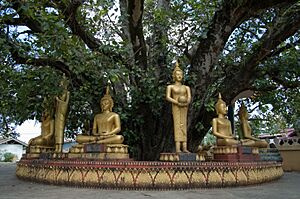
Early City States
Around the 6th century, people called the Mon people formed kingdoms in the Chao Phraya River Valley. By the 8th century, the Mon people moved north. They created city-states like Chantaburi, which is now Vientiane. These cities were not strongly connected politically. However, they shared a similar culture and adopted Therevada Buddhism from Sri Lanka.
The Story of Vientiane's Founding
An old Laotian story, the Phra Lak Phra Lam, says that Prince Thattaradtha founded Vientiane. He left his old kingdom and started a city called Maha Thani Si Phan Phao. This city is now Udon Thani in Thailand.
One day, a seven-headed Naga (a mythical snake-like creature) told the prince to build a new city. This new city was on the east side of the Mekong River, across from his first city. The prince named it Chanthabuly Si Sattanakhanahud. This city is believed to be the start of modern Vientiane.
Most historians think Vientiane was first a Mon settlement. Later, it was controlled by the Khmer Empire. When the Lao people and Thai people arrived in Southeast Asia from Southern China around the 11th and 12th centuries, they took over the area.
Under Khmer Rule
The name Vientiane first appeared in a Vietnamese writing from 1159. It said that in 1135, Văn Đan (Vientiane), which was part of the Khmer Empire, attacked Nghe An. The attack was stopped, and the invaders were chased away.
Lan Xang Kingdom and French Control
In 1354, Fa Ngum started the kingdom of Lan Xang. Vientiane became an important city for the government. In 1563, King Setthathirath made Vientiane the official capital of Lan Xang. This was done to protect it from attacks by the Burmese.
In 1707, the Lan Xang kingdom broke apart. Vientiane then became its own independent Kingdom of Vientiane. In 1779, a Siamese general named Phraya Chakri conquered Vientiane. It became a vassal state of Siam.
In 1827, King Anouvong led a rebellion that failed. Siamese armies destroyed Vientiane. The city was burned, and many Laotian treasures, including Buddha statues, were taken. Vientiane was in ruins and almost empty when the French arrived.
In 1893, Vientiane came under French rule. In 1899, it became the capital of the French protectorate of Laos. During this time, the city was rebuilt. Many Buddhist temples, like Pha That Luang and Haw Phra Kaew, were repaired.
During World War II, Japanese forces took over Vientiane easily. French soldiers later returned and took back the city in April 1945.
Becoming Independent
In 1953, Vientiane became the capital of the newly independent country of Laos.
Later, the Laotian Civil War started. Vientiane became a place of conflict. In 1975, troops from the Pathet Lao (a communist political movement) moved into the city. On December 2, 1975, the communist party took control of Vientiane. They ended the Kingdom of Laos and renamed the country the Lao People's Democratic Republic. This marked the end of the Laotian Civil War.
Vientiane hosted the 2009 Southeast Asian Games. Some sports were not included because Laos is landlocked and Vientiane did not have all the necessary facilities.
Vientiane's Location and Weather
Vientiane is located on a bend in the Mekong River. This part of the river forms the border with Thailand. The city government manages five urban areas within the Vientiane Prefecture.
Climate
Vientiane has a tropical savanna climate. This means it has clear wet and dry seasons. The dry season is from November to March. The wet season starts in April and lasts about seven months.
Vientiane is usually very hot and humid all year. However, temperatures are a bit cooler during the dry season. The coldest temperature ever recorded was 2.4 °C or 36.3 °F in January 1924. The hottest was 42.6 °C or 108.7 °F in April 2024.
| Climate data for Vientiane (1991–2020, extremes 1907–present) | |||||||||||||
|---|---|---|---|---|---|---|---|---|---|---|---|---|---|
| Month | Jan | Feb | Mar | Apr | May | Jun | Jul | Aug | Sep | Oct | Nov | Dec | Year |
| Record high °C (°F) | 36.0 (96.8) |
38.0 (100.4) |
40.2 (104.4) |
42.6 (108.7) |
42.5 (108.5) |
39.5 (103.1) |
38.2 (100.8) |
37.8 (100.0) |
37.5 (99.5) |
36.8 (98.2) |
36.0 (96.8) |
36.0 (96.8) |
42.6 (108.7) |
| Mean daily maximum °C (°F) | 29.0 (84.2) |
31.0 (87.8) |
33.4 (92.1) |
34.8 (94.6) |
33.6 (92.5) |
32.6 (90.7) |
31.8 (89.2) |
31.4 (88.5) |
31.7 (89.1) |
31.7 (89.1) |
30.8 (87.4) |
28.9 (84.0) |
31.7 (89.1) |
| Daily mean °C (°F) | 22.9 (73.2) |
24.8 (76.6) |
27.4 (81.3) |
29.1 (84.4) |
28.7 (83.7) |
28.4 (83.1) |
27.9 (82.2) |
27.6 (81.7) |
27.6 (81.7) |
27.2 (81.0) |
25.5 (77.9) |
22.9 (73.2) |
26.7 (80.1) |
| Mean daily minimum °C (°F) | 18.2 (64.8) |
19.3 (66.7) |
21.7 (71.1) |
24.2 (75.6) |
25.0 (77.0) |
25.4 (77.7) |
25.3 (77.5) |
25.0 (77.0) |
24.6 (76.3) |
23.9 (75.0) |
21.5 (70.7) |
19.2 (66.6) |
22.8 (73.0) |
| Record low °C (°F) | 2.4 (36.3) |
7.6 (45.7) |
11.7 (53.1) |
13.8 (56.8) |
19.1 (66.4) |
20.0 (68.0) |
19.5 (67.1) |
20.0 (68.0) |
18.8 (65.8) |
12.9 (55.2) |
8.9 (48.0) |
5.0 (41.0) |
2.4 (36.3) |
| Average precipitation mm (inches) | 7.4 (0.29) |
16.8 (0.66) |
43.8 (1.72) |
89.4 (3.52) |
225.6 (8.88) |
263.8 (10.39) |
299.8 (11.80) |
340.8 (13.42) |
265.0 (10.43) |
87.4 (3.44) |
15.4 (0.61) |
5.0 (0.20) |
1,663.2 (65.48) |
| Average precipitation days (≥ 1.0 mm) | 2 | 2 | 5 | 7 | 15 | 18 | 20 | 21 | 17 | 8 | 2 | 1 | 119 |
| Average relative humidity (%) | 70 | 68 | 66 | 69 | 78 | 82 | 82 | 84 | 83 | 78 | 72 | 70 | 75 |
| Mean monthly sunshine hours | 221.0 | 214.7 | 209.2 | 213.9 | 188.8 | 140.7 | 116.0 | 124.3 | 157.7 | 209.5 | 225.3 | 224.9 | 2,246 |
| Source 1: World Meteorological Organization, Deutscher Wetterdienst (extremes 1907–1990), Pogoda.ru.net, The Yearbook of Indochina (1939–1940) | |||||||||||||
| Source 2: NOAA (humidity 1961–1990), Extreme Temperature Around The World | |||||||||||||
Things to See and Do in Vientiane
Vientiane attracts many visitors with its beautiful temples and Buddhist monuments.
- Pha That Luang: This is a very important national monument in Laos. It is one of the most famous stupas (Buddhist shrines) in the country. King Setthathirath first built it in 1566. It was restored in 1953. This golden stupa is 45 metres (148 ft) tall. People believe it holds a relic of the Buddha.
- Wat Si Muang: This temple is also very popular with visitors. It was built in 1563 on the remains of an old Khmer Hindu shrine. You can still see parts of the old shrine behind the main hall. Legend says the temple is protected by the spirit of a local girl named Nang Si. She is said to have sacrificed herself when a pillar was being placed. A statue of King Sisavang Vong stands in front of the temple.
- Patuxai: This memorial monument was built between 1957 and 1968. It is probably the most famous landmark in the city. Its design was inspired by the Arc de Triomphe in Paris. However, it also has traditional Lao designs, like the Kinnari, a mythical bird-woman. You can climb to the top for a great view of the city.
- Buddha Park: This park was created in 1958 by Luang Pu Bunleua Sulilat. It has many Buddhist and Hindu sculptures spread out among gardens and trees. The park is about 28 kilometres (17 mi) south of Vientiane, right by the Mekong River.
Vientiane also has one of the few bowling alleys in Laos.
Other interesting places to visit include:
- Haw Phra Kaew: A former temple, now a museum with small shops.
- Lao National Museum
- Kaysone Phomvihane Museum
- Talat Sao Morning market
- That Dam: A large stupa.
- Wat Ong Teu Mahawihan: A Buddhist monastery.
- Wat Sri Chomphu Ong Tue: A Buddhist temple.
- Wat Si Saket: A Buddhist temple.
- Wat Sok Pa Luang: A Buddhist temple.
- Settha Palace Hotel: An old hotel established in 1932.
- The Sanjiang Market
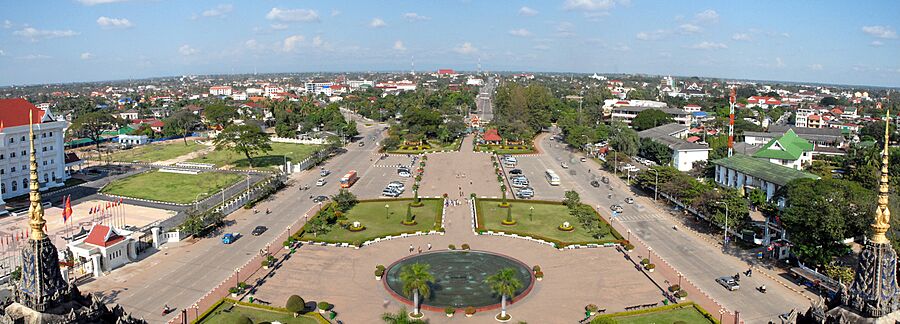
Learning in Vientiane
The National University of Laos is located in Vientiane. It is one of only three universities in the country.
There are also several international schools:
- Vientiane International School
- Lycée français international de Vientiane Josué-Hoffet (French school)
- Russian Embassy School in Vientiane
- Kiettisack International School
Economy and Business
Vientiane is a key city for economic growth in Laos. In recent years, the city has grown quickly due to money invested from other countries. In 2011, the Lao Securities Exchange (stock market) opened in Vientiane.
Getting Around Vientiane
By Bus
There are regular bus services that connect Vientiane Bus Station to other parts of Laos. Buses also run daily between Vientiane and cities in Thailand, like Nong Khai, Udon Thani, and Khon Kaen.
By Train
The First Thai-Lao Friendship Bridge was built in the 1990s. It crosses the Mekong River about 18 kilometres downstream from the city of Nong Khai in Thailand. This bridge is the main crossing point between Laos and Thailand.
A railway line crosses this bridge. It used to end at Thanaleng Railway Station, about 20 km east of Vientiane. Now, the railway has been extended further into the city. It ends at Vientiane (Khamsavath) railway station, which is a larger, newer station closer to the city center. This new station connects to the main bus terminal and the Laos China Railway Station. The first passenger train from Bangkok arrived here on July 20, 2024.
The Boten–Vientiane railway (also called the China–Laos railway) is a 414 kilometres (257 mi) long electric railway. It runs between Vientiane and the town of Boten on the border with China. This important railway line officially opened on December 3, 2021.
By Air
Vientiane is served by Wattay International Airport. This airport has international flights to other Asian cities like Singapore, Hong Kong, Malaysia, Thailand, South Korea, Japan, and China. Lao Airlines also has regular flights to many places within Laos.
Healthcare Services
The "Centre Medical de l'Ambassade de France" offers medical care to foreign residents in Laos. The Mahosot Hospital is an important local hospital. It works with the University of Oxford to treat and research diseases. The Alliance Clinic opened in 2011 near the airport and has connections to hospitals in Thailand. The Setthathirat International Clinic has doctors from other countries.
Vientiane Rescue provides a free, 24/7 ambulance service. It is run by volunteers and started in 2010.
Famous People from Vientiane
- Kanya Kounvongsa (born 1990), a Laotian football player.
|
See also
 In Spanish: Vientián para niños
In Spanish: Vientián para niños





